- Home
- John Scalzi
Unlocked: An Oral History of Haden's Syndrome Page 3
Unlocked: An Oral History of Haden's Syndrome Read online
Page 3
Benjamin Moldanado:
Around the time the First Lady was struck with the meningitis phase, some of the phase’s earliest victims were moving into what we began to recognize as a third, distinct phase of the disease. In this phase, for all intents and purposes, the victim’s voluntary nervous system shuts down—the victim can’t move, can’t speak, can’t even blink intentionally. The autonomic systems in most cases continued to function, so people could still breathe, and all the other critical life functions would continue more or less as they normally would. Cognitive function was likewise unaffected, to the extent that it had not been earlier affected by meningitis.
The short form of this was that people suffering from the third stage were essentially trapped inside their own bodies. They were conscious, awake and able to think, feel, and perceive the world around them. They just weren’t able to tell us they could do all these things. They were locked in.
At first, we only had a few reports of “lock in,” and we thought it might be the rare but not entirely surprising end game for a small handful of meningitis-phase sufferers, the next step beyond those who had developed significant cognitive impairment from the disease. But then the number exploded, and we realized that many of those who were experiencing lock in weren’t otherwise cognitively impaired—that there was no real correlation between cognitive damage and lock in. Like the first two rounds, some people got it and some people didn’t.
And one of those who got it was Margaret Haden.
Duane Holmes, Legislative Aide for Lynn Cortez, Speaker of the House:
Nothing got done. I mean nothing. To be fair to the President, very little was getting done anyway: The Republicans had the Senate and we had the House and neither chamber was passing much of anything that would get past the other. But each of us had our legislative agendas, and of course the President had his own, largely in line with the Senate’s. So we were all keeping busy.
Then the First Lady got sick and the President dropped everything. It wasn’t subtle, either. My boss got called into a meeting by [White House Chief of Staff Kenny] Lamb, who told her that until Margie Haden got better the President’s attention was going to be elsewhere. This didn’t sit well with the Speaker, because we were in the middle of trying to hammer out a long-term budget deal instead of doling out extensions like we had been doing. But Lamb made it clear the President had other things on his mind. My boss said that if he was going to be that distracted maybe he should let Vice President Hicks take over as acting executive in chief. I don’t think that went over particularly well.
My boss was irritated enough to ready a few jabs at the President about it, but [Senate Minority Leader Gordon] Harmon and his people pointed out to her that trying to take a punch at a man whose wife was gravely ill was not going to go over well at all. The Speaker agreed that she would give him a week but that was it. Sick wife or not, she had budget priorities, and she didn’t want to lose momentum on the discussion.
As it turned out, a week later two of the Speaker’s granddaughters were sick and she didn’t give a crap about the budget either. Nor did anyone else—there wasn’t a Congressperson on the Hill who didn’t have family or friends who were sick. This plague hit everyone.
Phyllida Yang, Professor of Pathology, New York University:
Haden’s syndrome really was a universal disease, and that’s something that’s more unusual than you might think. Part of this was that the initial vectors of infection were mobile, relatively high-status individuals: those epidemiologists who traveled across continents and came home to hospitals and universities, infecting as they went. The infection traveled as easily upward, in terms of social and economic classes, as it traveled downward. It wasn’t an outbreak focused on one particular group, as, for example, AIDS was initially in the US, when it first spread among urban gay men, or as modern day outbreaks of communicable diseases are among upper-middle-class children whose parents refuse to have them vaccinated. It went far and wide.
One consequence of this was that when it struck, there was a considerable knock-on effect because it was so widespread. Medical resources were overwhelmed, of course, but that was only the most obvious effect. Businesses came to a standstill not just because people called in sick but because spouses and parents stayed home to tend to the afflicted. Enough truckers got sick that perishable goods went bad waiting for someone to deliver them. Nearly every corner of American life was touched—and usually brought to a halt—by the initial outbreak of the disease. And as bad as it was here it was often worse in other countries, many of which did not have the infrastructure the US had built up over the years.
The one silver lining, if you want to call it that, of this universality of illness was that because everyone was either sick or knew intimately someone who was sick, there was immense political will for both short and long term solutions to the problems Haden’s presented. And in terms of political impetus to find solutions, no one was more motivated than the President himself.
Wesley Auchincloss:
After three weeks it was clear that Margie wasn’t coming out of it. Doctors elsewhere were reporting other patients by the thousands with the same issues she had, so we knew that what was happening to her wasn’t isolated or unusual. And it wasn’t something we could keep hidden from the press or the American people, either. It was around this time that the term “Haden’s syndrome” started to be used in reference to the disease, particularly the third stage of it. We tried to keep that from the President as long as we could, but that was a futile gesture. He heard it.
Dr. Harvey and her staff confirmed by MRIs and other tests that Margie was awake and conscious, so the President spent much of his time with her at Walter Reed, talking to her and reading those mystery novels she had as her guilty pleasure. Kenny Lamb finally had to pull him aside and tell him that despite his personal pain, the country needed a President, and that President needed to be seen leading and reassuring the country in this moment of crisis. When Kenny said this, the President gave him a look that, if I had to guess, communicated supreme apathy about the needs of the rest of the country. But after a minute he nodded slowly and told Kenny that the next morning he’d be ready to resume full activity as President.
Col. Lydia Harvey:
I remember that the President stayed up with the First Lady that entire night. I suggested to him that both he and the First Lady needed their rest, but he said, more politely than I suspect he really wished to, that he was the President and that no one could stop him from speaking to his wife. I told the medical staff to give him and the First Lady privacy and to intrude only if absolutely necessary.
Nevertheless around midnight I came into the room just before heading home myself. The President was sitting on his wife’s bed, facing away from me, holding her hand. I could hear him talking to her quietly. Most of it I couldn’t make out, but once or twice I heard him say, “Tell me what I should do. Tell me what I need to do, Margie. Tell me.”
It was a strangely intimate moment and I felt that I had intruded on something that the President did not intend nor would want me to see. I slipped out of the room before he could notice I was there, waited a moment and then knocked on the door before entering a second time, to give the President time to prepare himself. The Secret Service agents guarding the door gave me a look when I did this but as far as I know they kept quiet about it, too. I think they understood what had happened.
Wesley Auchincloss:
Kenny and I came into the Oval Office at 8am the next morning and were surprised that the President already had the Vice President, the Secretary of State, the Secretary of Health and Human Services, the Speaker of the House, and the Majority Leader of the Senate in there with him. We had been under the impression that the meeting would be the usual agenda setter between me, Kenny, and the President. The looks we got from every other member of the meeting suggested to us that they were at least as surprised to be at the meeting as we were. We found out after the meeting
that the President called each of them personally at around 5am and told them to be in the Oval Office or face the consequences, “the consequences” being unspecified but dire. He didn’t call me or Kenny, I suppose, because he knew we were coming anyway.
When we were all there, the President looked at each of us and said something along the lines of, I’ll make this simple. We’re going to find out what this disease is, we’re going to cure it and we’re going to help the people who are locked in their bodies find a way to get out, because we’re the greatest nation in the world, and if we could build the atom bomb and put a man on the moon, we sure as hell can do this.
And then Speaker Cortez said, in that way of hers, “Well, Mr. President, that’s going to cost money.” The President said that he didn’t care. [Senate Majority Leader] Caleb Waters reminded him that he’d been elected on a platform of slashing taxes and cutting government expenditures. The President stared straight at Waters and said, and this a direct quote, “That was then.” Waters opened his mouth to say something else and the President said to him that he needed to listen very carefully, this was going to happen and that if anyone got in the way of it happening, regardless of party, regardless of position, he would screw them into the ground so hard that they would end up ass-first in China.
Which would have been an amusing way of putting it except that I have never, not before or since, seen the President as deadly serious as he was being at that exact moment. Waters shut his mouth and waited for what the President had to say next.
And what he said next was simple. He said to Waters and Cortez that as far as he was concerned this initiative was the sole task of the federal government from that point forward. How they wanted to get it done in their respective chambers was up to them but they had three months and no more to get a bipartisan bill on his desk, one that had more than two-thirds support in both chambers.
Left unsaid was what would happen if the bill failed to materialize in the appointed time. I think in her autobiography Cortez said she thought the President was hinting that martial law was not out of the question. There’s not much that I would agree with Cortez on, politically or otherwise, but I think she was spot on with this one. To be blunt, the President was not fucking around with this one. It wasn’t political, it was personal.
Duane Holmes:
It got done. It nearly killed everyone in Congress, and everyone in Congress ended up wanting to kill everyone else, but two weeks before the deadline the President had the Haden Research Initiative Act on his desk. 300 billion dollars allocated for medical and technological research and treatment for that first year, officially, and unofficially, whatever it cost to get things moving. It ended up costing three trillion dollars by the end of it. That’s a hell of a lot of money.
It got done for two reasons. One, there wasn’t anyone in the US who wasn’t affected by the syndrome. Republican, Democrat, liberal, conservative, hippie and gun nut, atheist and evangelical, it didn’t matter. Someone in your family got sick. One of your friends got sick. One of your co-workers got sick. You got sick.
Two, and I say this as a member of the loyal opposition, President Haden simply would not take no for an answer. He worked to pack the Congressional hearings with witnesses who would appeal on both sides of the aisle—the day [former NBA star and Basketball Hall of Famer] Marcus Shane came to testify I don’t think I’ve seen so many grown men and women act like children scrambling for autographs. And then Shane talked about how the disease had locked in his kid and I saw [Senate Appropriation Committee Chairman] Owen Webster—that heartless bastard!—openly sobbing into his microphone. That’s when any doubt I had that this thing was going to get done evaporated.
There were a few holdouts. David Abrams, who was then a backbencher representative, made a lot of noise on the radio talk show circuit about the cost and the threat of new taxes and the expansion of big government and so on, and even took a few swipes at the President, despite them being of the same party. I understand Haden let it slide by until Abrams made a crack about the First Lady to a Tulsa talk show host. By the end of the day, as I understand it, Abrams was having a very intimate discussion with the NSA, and they showed him some pictures they had or something, and then that was the last anyone heard of Abrams until the act passed. He even voted for it and everything.
Thomas Stevenson:
I can’t say that I have any recollection of the NSA ever meeting with David Abrams at the time. You might ask him. I would be interested in what he has to say on the matter.
Neal Joseph:
Look. At the end of the day, it came down to this: the President wanted his wife back. He was willing to do anything to make that happen. And he was President of the United States, which meant he was able to do anything to make it happen. As a side effect, millions would ultimately benefit from the decision, but make no mistake. Benjamin Haden was being purely, entirely and unabashedly selfish. He loved his wife, he was lost without her, and he wanted her back. End of story.
Could you blame him for it? Could anyone blame him for it?
PART THREE: THE MOON SHOT
Irving Bennett:
The Haden Research Initiative Act was sold to the public as a “moon shot”—as in, we went from Kennedy saying we would go to the moon to Armstrong setting foot on it in nine years because we decided as a nation that we would, and we put the resources and willpower to work. President Haden made it clear that he wanted the same unity of purpose here. And of course everyone got behind it because the syndrome touched everyone’s life to a greater or lesser extent.
But it didn’t change the fact that the first year of the HRIA was complete chaos. National unity of purpose is fine, but when it comes to spreading $300 billion around, logistics and a solid plan is better. And it was clear that at least at the outset, no one had a plan on how to apportion the money, to allocate resources for research and development, or to set concrete goals. The US government basically threw all that money into the air and yelled “go” to whoever grabbed it.
Haden and the rest of the government quickly realized that, and Haden in particular was incensed. He may have forced the creation of one of the biggest social programs in the history of the United States, but he still had “skinflint Republican” in his bones. The idea that his signature legislative achievement would be seen as a call to slop the pigs was something that outraged him. He sicced [Attorney General Gayle] Garcia on several companies and C-suite executives—including ones who had contributed to his election, an unheard of thing in any political era—and eventually people took the hint.
By the end of the first year things had settled out into four main buckets. One was simply for the medical maintenance of all the people who were afflicted, who weren’t already covered by insurance, plus more federal backstopping for the insurance companies, who were screaming bloody murder about costs. Of the three left, one was for research into a vaccine, one for research into the brain, and the one for mobility and community research. Find a cure, communicate with the victims, get them reintegrated back into the world. It was the brain research that took off first.
Ida Garza, Former Deputy Programs Coordinator, HRIA, Department of Health and Human Services
My job was to coordinate research across several different private companies, the CDC, and other divisions of Health and Human Services and various public and private universities, with a focus on brain research. And it was a nightmare. Primarily because each of these groups were used to shielding their intellectual property from the outside world, until such time as they could file patents or otherwise move to protect their work.
The thing with the HRIA was that as a condition of receiving funding, all the work, including work in progress, had to be submitted to a searchable database so that everyone else receiving funding could see the work and use it to advance their own work—because above anything else, we had a mandate to get advances and therapies to the patients as quickly as possible. The HRIA still allowed for patent fil
ings, but everything, everything, was cross-licensed for the length of the patent, for a statutory fee that went into effect only after a product went to market.
This simply wasn’t the way things had ever been done before, and so I had to deal with CEOs and chairpeople calling me up and yelling at me that they were leaving money and profits on the table. I would remind them of just how much HRIA funding they were shoveling into their companies and that they knew what the conditions were on that money. They would respond with baffled silence. Occasionally one would threaten to go over my head and talk to the Secretary, or, God forbid, the President himself.
I was secretly delighted when they would say that, because I had a standing order when that happened to refer them immediately to the White House, at which time the Chief of Staff would read them the riot act. A couple of times I understand the President himself got on the line to do the honors. I was never a huge fan of President Haden before the HRIA but I appreciated him after the fact, because he simply took no crap from anyone about how the HRIA was run. You opened up your research or you didn’t participate. And there was so much money involved that eventually everyone gave in.
Sharing data that way was not really the optimal way of doing things. If any of us at HHS could have changed it, we would have done things Manhattan Project style, where we sent all the researchers into the desert together until they came up with things we could use. But this set-up allowed the communal effort to have at least a thin veneer of free enterprise, and that was politically important, considering the administration.
And at the end of it all, it worked. The first neural networks came about because research on detecting brain activity by way of MRI and other external devices at Stanford was combined with physical deep brain stimulation research at the Cleveland Clinic by a scientist working at General Electric. If they hadn’t been able to see each other’s work, they all would have had to reinvent those particular wheels. This way the wheel only had to be invented once.

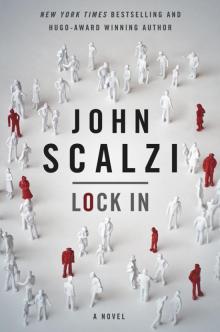 Lock In
Lock In Clash of the Geeks
Clash of the Geeks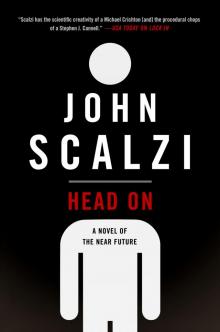 Head On
Head On The Dog King
The Dog King Old Man's War Universe: Short Stories
Old Man's War Universe: Short Stories The End of All Things
The End of All Things Tales From the Clarke
Tales From the Clarke The Human Division
The Human Division The Android's Dream
The Android's Dream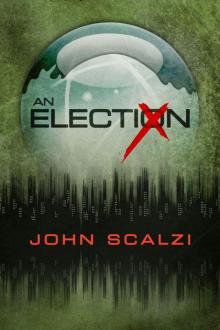 An Election
An Election Zoe's Tale
Zoe's Tale Agent to the Stars
Agent to the Stars This Hollow Union
This Hollow Union The Gentle Art of Cracking Heads
The Gentle Art of Cracking Heads Old Man's War
Old Man's War The Tale of the Wicked
The Tale of the Wicked Your Hate Mail Will Be Graded: A Decade of Whatever, 1998-2008
Your Hate Mail Will Be Graded: A Decade of Whatever, 1998-2008 Judge Sn Goes Golfing
Judge Sn Goes Golfing The Back Channel
The Back Channel The Human Division 0.5 - After the Coup
The Human Division 0.5 - After the Coup Fuzzy Nation
Fuzzy Nation The Observers
The Observers This Must Be the Place
This Must Be the Place The Last Colony
The Last Colony Unlocked: An Oral History of Haden's Syndrome
Unlocked: An Oral History of Haden's Syndrome A Voice in the Wilderness
A Voice in the Wilderness Redshirts
Redshirts The Collapsing Empire
The Collapsing Empire The Last Emperox
The Last Emperox The God Engines
The God Engines A Problem of Proportion
A Problem of Proportion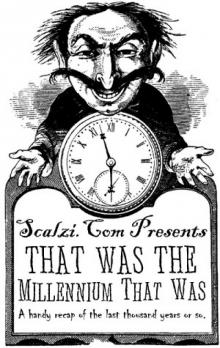 THAT WAS THE MILLENIUM THAT WAS
THAT WAS THE MILLENIUM THAT WAS The B-Team
The B-Team The Sound of Rebellion
The Sound of Rebellion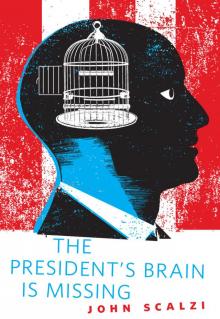 The President's Brain Is Missing
The President's Brain Is Missing Questions for a Soldier
Questions for a Soldier Walk the Plank
Walk the Plank We Only Need the Heads
We Only Need the Heads How I Proposed to My Wife: An Alien Sex Story
How I Proposed to My Wife: An Alien Sex Story Earth Below, Sky Above
Earth Below, Sky Above Everything but the Squeal
Everything but the Squeal Old Man’s War
Old Man’s War The Human Division #12: The Gentle Art of Cracking Heads
The Human Division #12: The Gentle Art of Cracking Heads This Must Be the Place thd-10
This Must Be the Place thd-10 A Voice in the Wilderness thd-4
A Voice in the Wilderness thd-4 The Observers thd-9
The Observers thd-9 The End of All Things: The Fourth Instalment
The End of All Things: The Fourth Instalment Earth Below, Sky Above thd-13
Earth Below, Sky Above thd-13 Zoe`s Tale вбиос-4
Zoe`s Tale вбиос-4 After the Coup
After the Coup Miniatures: The Very Short Fiction of John Scalzi
Miniatures: The Very Short Fiction of John Scalzi The Last Colony вбиос-3
The Last Colony вбиос-3 Tales From the Clarke thd-5
Tales From the Clarke thd-5 Old Man's War omw-1
Old Man's War omw-1 The Human Division #8: The Sound of Rebellion
The Human Division #8: The Sound of Rebellion The Ghost Brigades omw-2
The Ghost Brigades omw-2 The Sagan Diary (old man's war)
The Sagan Diary (old man's war) The Sound of Rebellion thd-8
The Sound of Rebellion thd-8 The Human Division 13 - Earth Below, Sky Above
The Human Division 13 - Earth Below, Sky Above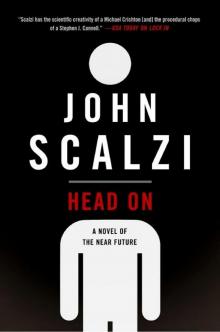 Head On_A Novel of the Near Future
Head On_A Novel of the Near Future The End of All Things: The First Instalment
The End of All Things: The First Instalment The B-Team thd-1
The B-Team thd-1 The Back Channel thd-6
The Back Channel thd-6 Walk the Plank thd-2
Walk the Plank thd-2 The Human Division #9: The Observers
The Human Division #9: The Observers The End of All Things: The Third Instalment
The End of All Things: The Third Instalment The Human Division #10: This Must Be the Place
The Human Division #10: This Must Be the Place The End of All Things #2: This Hollow Union
The End of All Things #2: This Hollow Union We Only Need the Heads thd-3
We Only Need the Heads thd-3 Metatropolis
Metatropolis The Dog King thd-7
The Dog King thd-7 The Consuming Fire (The Interdependency)
The Consuming Fire (The Interdependency) The Human Division #11: A Problem of Proportion
The Human Division #11: A Problem of Proportion